Patriotic Container Gardens for Summer Celebrations
The Historic Red, White and Blue
Red, White and Blue is the iconic color scheme of an American summer. These colors each have deep meanings and various interpretations. American revolutionaries adopted these colors for our colonial flags beginning in 1776. Yet red, white and blue were also the colors of the British flag, and the British Red Ensign Flag, a field of red with a Union Jack in the upper left corner, which flew over Colonial and British ships from 1707-1801.
Many of the earliest flags used in the colonies, and during the early Revolutionary period, were variations of this basic design using two or three colors of the basic red, white and blue theme. A green pine tree silhouette, symbolizing freedom, was placed on the ‘Bunker Hill Flag,’ flown on Colonial American ships prior to 1707. It features a field of blue, with a large red cross superimposed on a white rectangle in the upper left corner. The green pine tree icon was also used on some flags used by certain regiments during the Revolutionary War, including the Continental flag used in the New England colonies, and the Washington Cruisers flag, used from the fall of 1775 on Colonial ships outfitted by George Washington to patrol Massachusetts Bay.
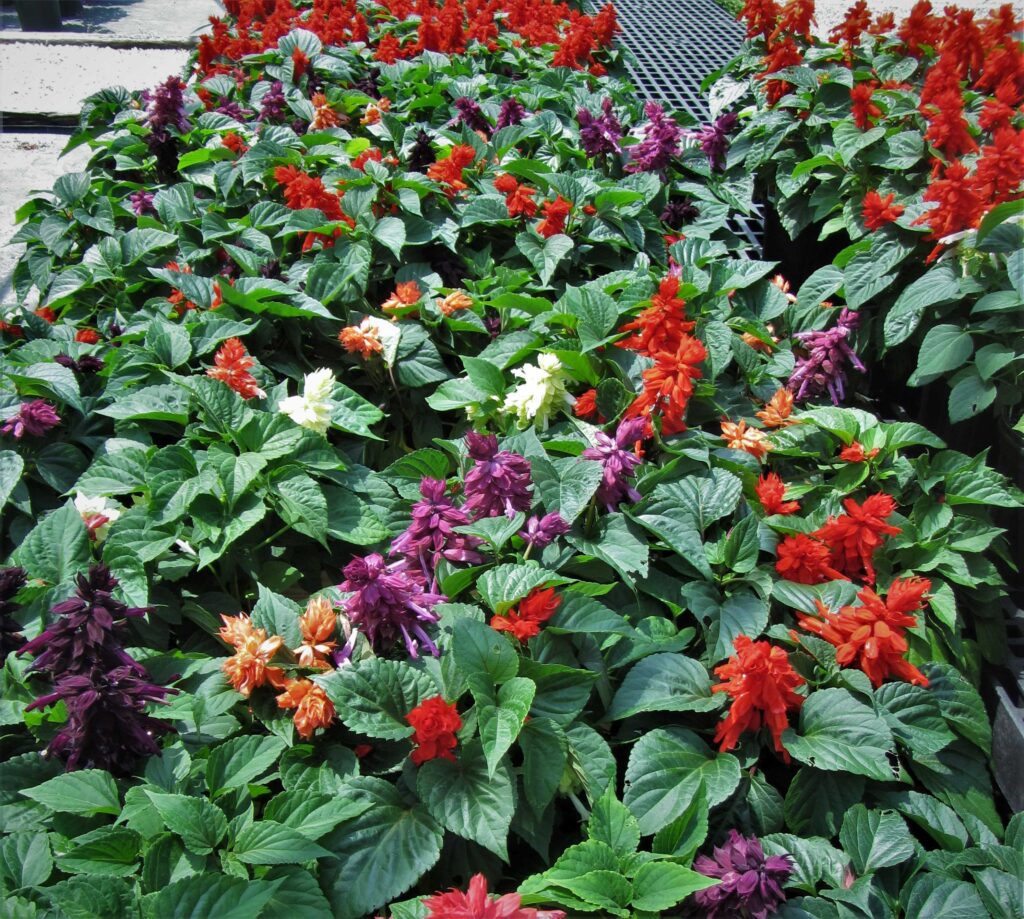
Salvia splendens comes in a variety of colors. All are sturdy, easy to grow annuals that attract hummingbirds and other pollinators.
Students of history will remember seeing white flags with red crosses dating back to the Twelfth Century. The Knights Templar used the design of a white field and a large, red Jerusalem cross on their banners, tunics, and on their ships’ sails. European explorers in the New World used variations of this design on their sails and flags through at least the Fifteenth Century. The red cross on a white field is also the design of a flag used by the Grand Council of the indigenous Mi’kmaq people of Northeastern Canada.
French revolutionaries also chose red, white and blue as the colors of their movement to depose the French monarchy, beginning in 1789. These three colors, used together, symbolize freedom throughout the modern world. But why these particular intense shades of crimson red, royal blue and pure white?

Impatiens hawkeri, tuberous Begonias and Dichondra ‘Silver Falls fill this basket planted for partial sun or dappled sun with red, white and silver.
The Meanings of the Colors
Charles Thompson, who was the Secretary of the Continental Congress when the design for the first American flag (the ‘Betsy Ross Flag’) was adopted in 1776, and who worked closely with the committee which designed the flag, explained the meanings of the colors in this way:
“The colors of the pales (the vertical stripes) are those used in the flag of the United States of America; White signifies purity and innocence, Red, hardiness & valour, and Blue, the color of the Chief (the broad band above the stripes) signifies vigilance, perseverance & justice.”
From this we learn that the three colors of our national identity stand for purity, innocence, hardiness and valor, vigilance, perseverance, and justice. These are universal ideals that we celebrate during the summer holidays from Memorial Day at the end of May through Independence Day in July, and finally at Labor Day in early September.
Living Floral Arrangements in Patriotic Colors
Although people traditionally decorate for these holidays with American flags, banners and bunting, we can easily pull together living floral arrangements in containers to decorate our outdoor spaces in patriotic colors from Memorial Day through summer’s end in September. Summer annuals and tender perennials that are widely available combine well in container plantings and will bloom repeatedly throughout the summer.
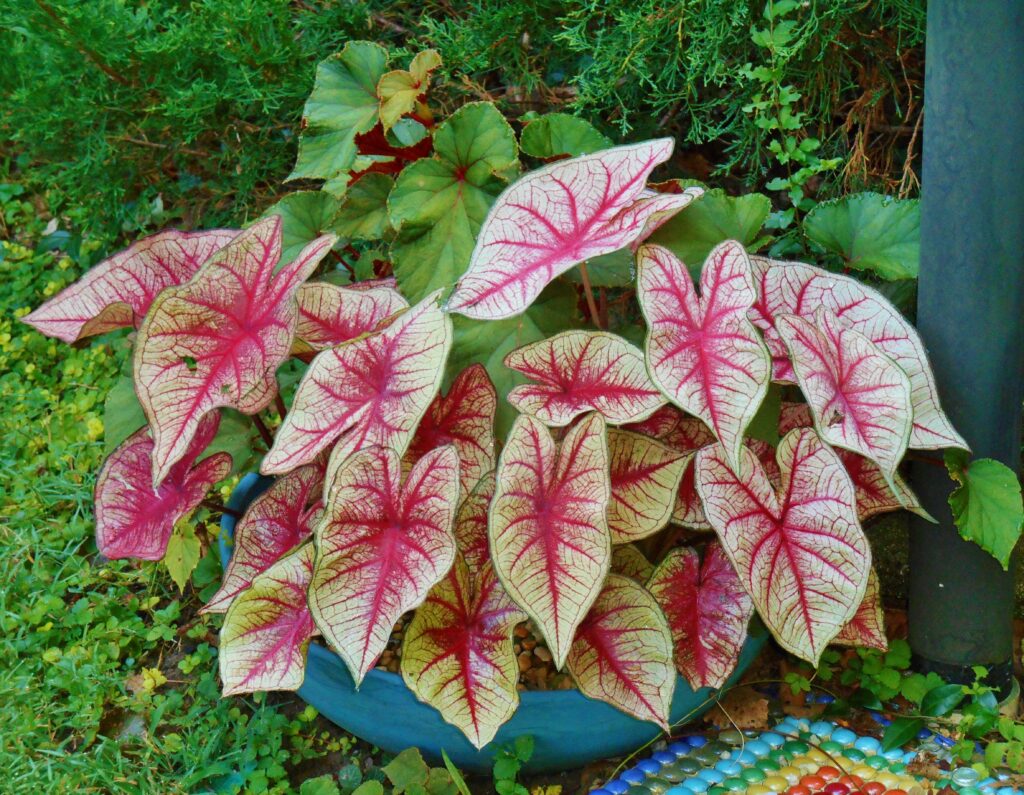
Caladiums are grown for their leaves rather than for their flowers. Hybrids with red and white markings on their leaves are an excellent choice for container plantings in part to full shade. Some newer hybrids will thrive in full sun, so long as the soil is kept moist. Caladiums are heavy feeders. Deer rarely touch them.
Let the Container Set the Mood
The container is an important part of any potted arrangement because it sets the mood, and also determines the success of the planting. The container needs to be large enough for all of the plants to establish strong roots systems. It should have good drainage, but also retain moisture so the arrangement stays moist without frequent watering. When combining three or more plants, a rectangular window-box style container should be at least 14” long and 6”-8” deep. A round container should be at least 14” in diameter and 10″-12” deep. The containers need drainage holes.
Select plastic, ceramic, wood, concrete, or composite materials for the containers, keeping in mind that the container may carry one of the three colors in the display. Paint concrete or wooden containers red, white, blue, or some combination of these. Choose shiny ceramic containers in bright red, pure white, or royal blue, and fill them with flowers of the other two colors. Plastic containers may be covered, mosaic style, with ceramic or glass tiles. Choose a strong glue designed for use on plastic to attach the tiles, and then grout between the tiles for a beautiful finish.
Hanging baskets may be wire frames lined with a natural fiber liner. It is wise to add a sheet of thin plastic, with holes punched in it, inside the fiber liner to help retain moisture in the soil on hot, sunny days. Cut a cellulose sponge into small chunks and distribute these throughout the planting mix, particularly near the bottom and around the outside edge, to retain even more water and release it slowly, as needed.
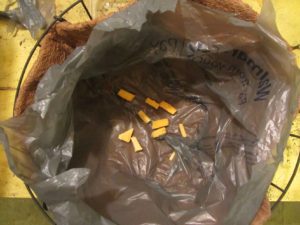
Line wire frame hanging baskets with recycled plastic. Poke a few drainage holes in the plastic along the bottom edge of the liner. Add small chunks of a cellulose sponge to help retain moisture in the planting medium.
Medium and Method
Use a good commercial potting mix as the planting medium. If the container is large, move it to where it will be displayed before filling and planting it. Enrich the mix, if you plan to plant heavy feeders, with worm castings, mushroom compost, or even a little leaf compost mixed into the medium around the root zone of the starter plants.
Group Plants With Similar Needs Together
All of the plants used in a container should have similar needs for water and light. Study the area where the container will be placed to determine whether it gets at least 6-8 hours of direct sun for ‘full sun’ plants. Anything less than 2 hours of direct sun would be appropriate for ‘shade’ plants. Many of our favorite summer plants will bloom in ‘part sun’ or ‘part shade.’ Knowing that hot, dry weather is coming, feel comfortable in allowing even ‘full sun’ plants a few hours of shade, especially in late afternoon, to recover from the heat of the day.
Step-by-Step for Planting Success
Fill the container to within 4″ of the rim with the planting medium. Place the largest plant first in the center of the pot, if the arrangement will be visible from all sides. If it will be placed against a wall or railing, then set the largest plant towards the rear of the container. Place the other plants in the arrangement with an awareness of how large they will grow during the season so the arrangement is full without being too crowded.
Remove each plant from its pot and gently tease apart roots that may be circling the root ball to assist them in growing out into the new medium. Work on loosening any tangled roots at the bottom of the root ball, without breaking or tearing any roots nearer the root collar of the plant. Set the root balls so the crown of each plant will be about 2″-3″ below the rim of the pot. Scoop out space for larger plants, and fill in with additional potting soil around the smaller plugs. All plants should set at the same level in the soil, and none should have more than a half inch of fresh soil above their root ball, at the level it sat in the nursery pot.

Hellebores and Violas bloom from late winter through spring. Aquarium gravel protects the plants from splashing soil, keeping them healthier and cleaner.
When all of the plants are in the container, smooth the surface of the medium, water in well, and consider topping the surface with a gravel or bark mulch to keep the plants clean, hold moisture in the soil, and prevent disease on the lower leaves of the plants. Fertilize the finished planting with time-release fertilizer designed for container plantings, and make a note to add another dose later in the season, according to package directions.
Here are a few plants to consider for your plantings, which perform well in our area:
Full Sun to Part Sun
Zonal and Ivy Geraniums– Find Zonal geraniums, Pelargonium x hybridum, in most garden centers from April through early June. Zonal geraniums form mounds with clusters of flowers held on upright stems. Most varieties grow to between 12”-20” tall. Ivy geraniums, Pelargonium peltatum, which trail on long, more flexible stems, are sometimes more challenging to find. These are tough plants which will survive drying out a little between waterings, though they perform best when the soil stays moist, but not wet. These are heavy feeders and bloom better when boosted with fertilizer dissolved in water once or twice a month. Remove spent flowers by snapping the petiole off at the main stem.
Deer resistant, attracts pollinators
Verbena x hybrida –Hybrid, low growing Verbenas come in a range of colors and are easy to find in garden centers beginning in April. Some varieties have variegated flowers. There are purple or blue flowers sometimes available, along with shades of red and white or cream. These are mounding and trailing plants which will grow to 6”-8” tall before trailing over the sides of the container. These tough plants bloom continuously. They are somewhat drought tolerant, but perform best in consistently moist, not wet, soil with supplemental feeding. Deadhead spent blooms to improve appearance and to promote bushiness.
Deer resistant, attracts pollinators

Salvia splendens, sometimes called scarlet sage, is available in a variety of colors. The ‘blue’ variety is actually more of a purple.
Salvia ssp.
Salvia splendens- Scarlet Sage is sold as an annual in our area, often as plugs in a 4 or 6 plant pack in shades of bright red, white and purple. A perennial in Zones 10-12, this easy to grow sage blooms continuously in full to part sun. It is a fast grower with vivid, showy flowers and will bloom continuously until frost. Remove spent blooms to encourage more flowers.
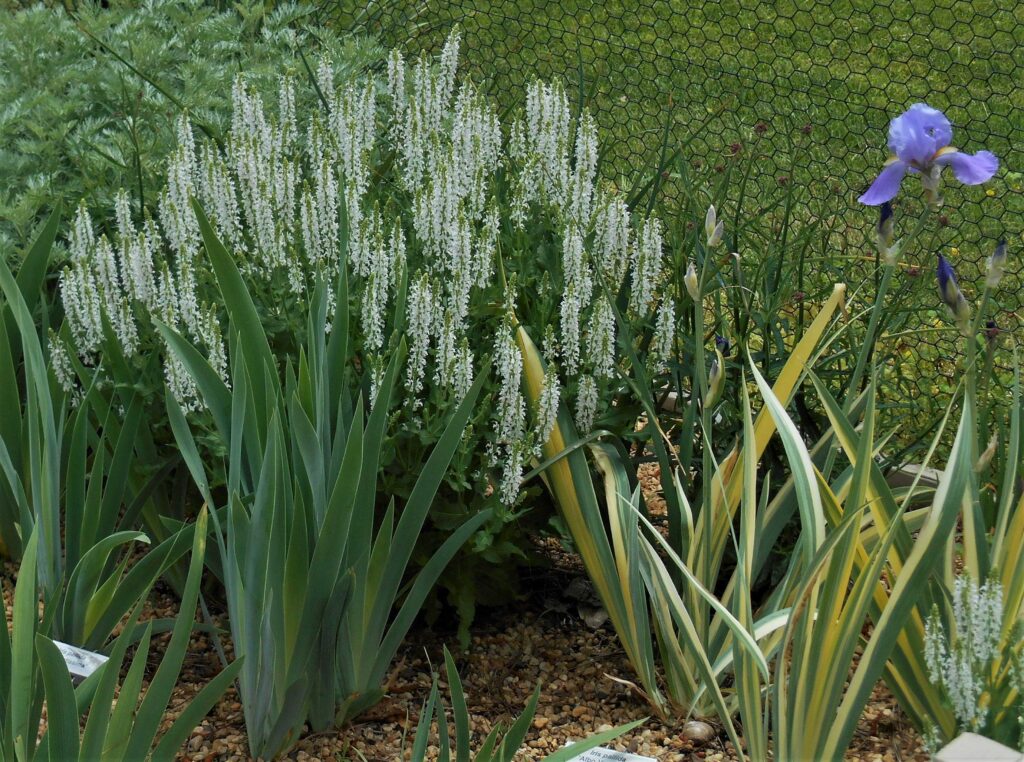
Meadow sage, S. pratensis, grows into a substantial plant over the season. There are several nice white varieties. Photo from the Williamsburg Botanical Garden and Freedom Park Arboretum
S. farinacea Mealy cup sage- ‘Victoria Blue’ and ‘Victoria White,’ hardy to Zone 8a, may be purchased as plugs in 4 packs or 6 packs at garden centers in the spring. Sold as annuals, these plugs grow quickly into plants 2’-3’ tall and up to 2’ wide. They flower prolifically all season in full sun. These are upright, mounding perennials. Deadhead spent flowers to encourage bushiness and to keep the flowers coming.
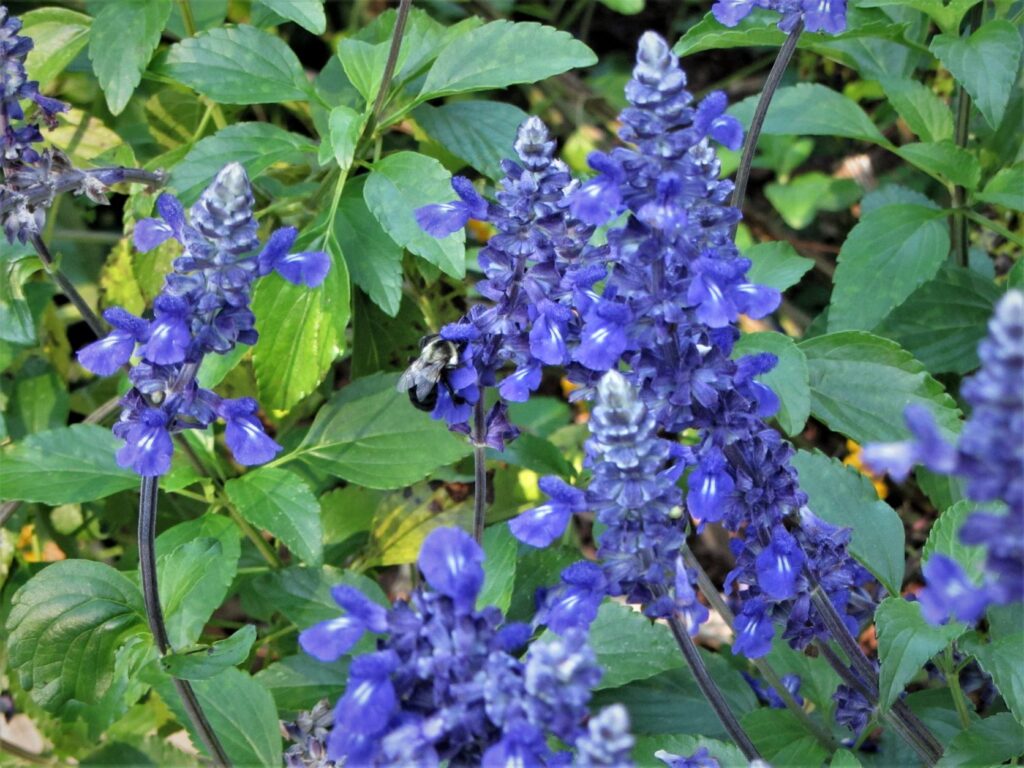
Hybrid Salvia ‘Mystic Spires’ is always one of the busiest plants from May through frost, feeding a wide variety of pollinators. Williamsburg Botanical Garden and Freedom Park Arboretum.
‘Mystic Spires Blue’ is a hardy hybrid Salvia with deep blue flowers. S. farinacea is one of the parents of this extremely successful hybrid, reliably hardy to Zone 7. Somewhat drought tolerant and very deep rooted, this Salvia grows to around 2’ tall, with the spikes of flowers growing another 2’ tall beyond the plant. Performs best in consistently moist soil in full to part sun. Look for this perennial sold usually in gallon pots at the garden center.
Deer resistant, attracts pollinators
Pentas lanceolata Egyptian Star Flower- This tender perennial, hardy in Zones 10-12, is grown as an annual in our area. Growing to 2’ tall and wide, this mounding, neat plant blooms continuously with clusters of tiny flowers attractive to hummingbirds and other pollinators. Common varieties bloom in shades of red, rose, pink, violet and white. Grow in full to partial sun in fertile, moist soil. Dead head to encourage more flowers.
Deer resistant, attracts pollinators
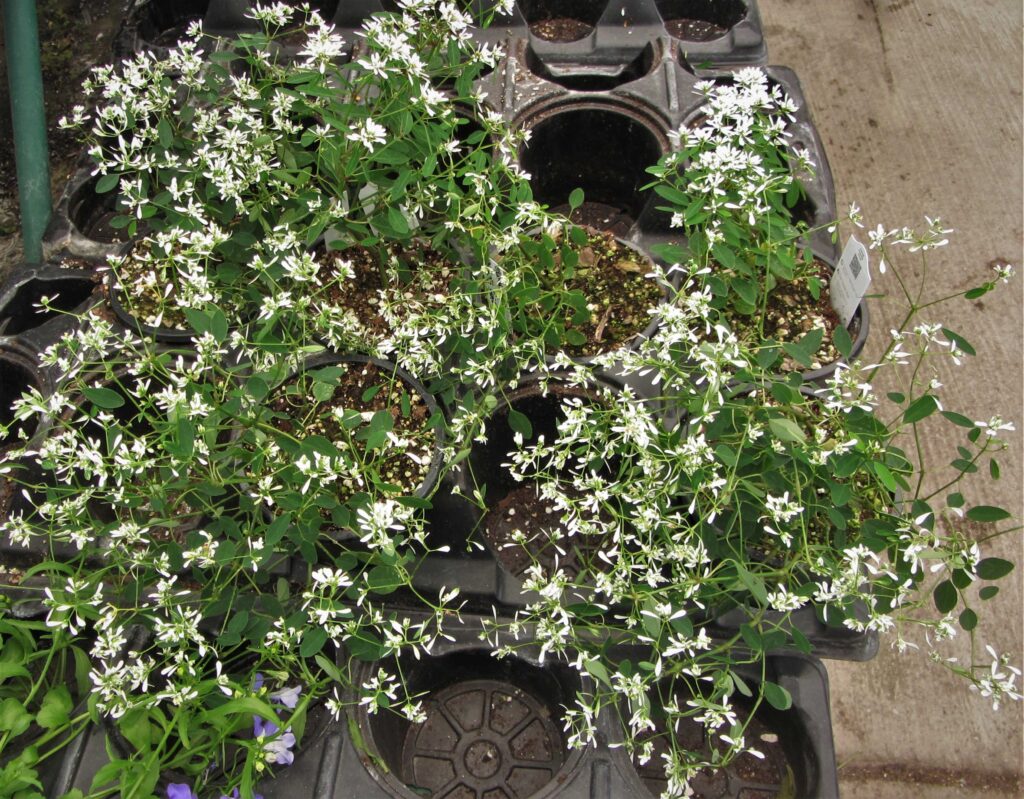
There are several varieties of baby’s breath Euphorbia available in garden centers during early summer. Some have variegated leaves.
Euphorbia hypericifolia Baby’s Breath Euphorbia has tiny white flowers on soft, multi-branched stems. Growing to 2′ tall and wide, it is a great filler and trailing plant in containers and baskets. Drought tolerant, this plant grows well in full or part sun. It is a tender perennial hardy in Zones 10 and 11. The milky sap of all Euphorbias can irritate the skin, and will cause nausea if ingested. This plant is resistant to herbivores.

Calibrachoa hybrids have slightly smaller flowers than Petunias, but the plants are similar in appearance and culture.
Petunia x hybrida Petunia and the closely related Calibrachoa x hybrida come in a wide selection of bright, intense colors. Flowers are funnel shaped, much like a morning glory. These mounding and trailing plants may grow 6”-10” tall, but trail for several feet below the rim of the container. Plants prefer fertile, evenly moist soil in full to part sun. Pinch stems and deadhead regularly to keep plants neat, bushy, and productive. This plant gets easily stressed if it dries out, particularly if it is also in direct sun. Calibrachoa, from South and Central America, is hardy to Zone 7. Petunia, from South Africa, is hardy to Zone 10.
Attracts hummingbirds and other pollinators, may be grazed by herbivores
Dianthus ssp. Dianthus, also knows as pinks or French Mignonette, are sturdy, evergreen perennials that bloom over a long season in full to partial sun. Flowers may be the size of a quarter or smaller in most varieties available locally. Plants are frequently sold as plugs in 4 packs or 6 packs in both spring and fall. Some species are more upright, to 2’ and others have softer stems and serve as a spreading groundcover in rock gardens or the front of containers. Drought tolerant. Look for bright white and crimson red flowers.
Deer resistant, attracts pollinators
Lobelia erinus, Lobelia is a low growing mounding or trailing annual, to about 6” tall, with small blue or white flowers. It doesn’t require pruning or deadheading, but does want consistently moist, fertile soil in full to part sun. It is poisonous if eaten. Grow this in the front and along the edges of beds and containers.
Lobelia cardinalis, cardinal flower is a red flowering Lobelia normally grown as a naturalized perennial in wet soils. It can be grown in a container if the soil is kept consistently moist, and can grow to 4′-5′ tall and 2′ wide in full to partial sun.
Celosia argentea var. plumosa Feather Celosia loves the heat and humidity. It is a tender perennial, hardy in Zones 9-11 and has naturalized in many parts of Africa, Central and South America, as well as Asia. An important plant in its native India and Nepal, Celosia may be used in containers, for bedding, or as a cut flower. Plants may grow to 3′ tall where they are happy in moist, fertile soil with full sun. Deadhead spent flowers to encourage more bloom. This plant is related to the grain Amaranth, is edible in small quantities, and may be grazed by deer and rabbits. Use it to give an airy feeling to container arrangements. It may also used as a dried flower.

Angelonia is a beautiful annual, but the blue variety is more purple than blue. There is a white variety, but no red.
Angelonia angustifolia Summer snapdragon- is a vigorous mounding tender perennial that blooms continuously until frost in full sun. It grows 1’-4’ tall and 1’ wide, and doesn’t require deadheading or staking. It is extremely both heat and drought tolerant, reliable and easy in containers. Plants have white, pink, purple or blue flowers.
Attracts pollinators, may be grazed by herbivores

Gaura, a native perennial, may be available with white or with pink flowers. Some new varieties have variegated leaves.
Oenothera lindheimeri Butterfly gaura- This Southeast US native perennial, hardy to Zone 5, develops a thick taproot to anchor its tall, wispy stems covered in small flowers from spring through frost. It serves as the larval host for the white lined sphinx moth. The plant begins as a small mound before quickly expanding into a spreading, vase shaped display. It may grow to 5′ tall and 3′ wide, but each stem remains thin and blows about in the slightest breeze. This is a stunning plant in full bloom and much loved by hummingbirds, long tongued bees, butterflies, and other pollinators. Plant in moist, organically rich soil and grow in full to partial sun. It is tolerant of heat, drought, and humidity. Stems root easily in moist soil. (This plant’s genus was changed from Gaura to Oenothera in the early 2000s.)
Attracts pollinators, deer resistant
Agastache ssp. Hummingbird Mint- This very tough, hardy perennial is a native member of the mint family and is a magnet for hummingbirds, butterflies, and other pollinators. It is drought tolerant once established and will bloom until frost. There are 22 species and cultivars, many of them in shades of white or blue. Hummingbird mint forms a neat mound that doesn’t run and spread like culinary mints. The plant’s size is determined by variety, but most grow from 12″ (dwarf) to 4′ tall and 3′ wide in most any soil. Its essential oils protect it from grazing herbivores. Deadheading isn’t required, but cutting the plants back a time or two during the growing season produces bushier plants and more flowers.
Deer resistant, attracts hummingbirds and other pollinators

Bedding Begonias will grow to about a 1′ tall and wide in partial to full shade. Some newer hybrids are advertised to take full sun, but more than a few hours of direct sun in our region will cause the edges of their leaves to crisp. Flowers come in white, red and pink.
Shade
Begonia ssp. bloom reliably in partial sun to shade. Some varieties will bloom with no direct sun at all. There are various sizes and types of Begonias, and many are grown for their colorful leaves more than for their flowers. However, many varieties bloom with white or red flowers. Some also have red leaves, or variegated leaves with red and silver markings.
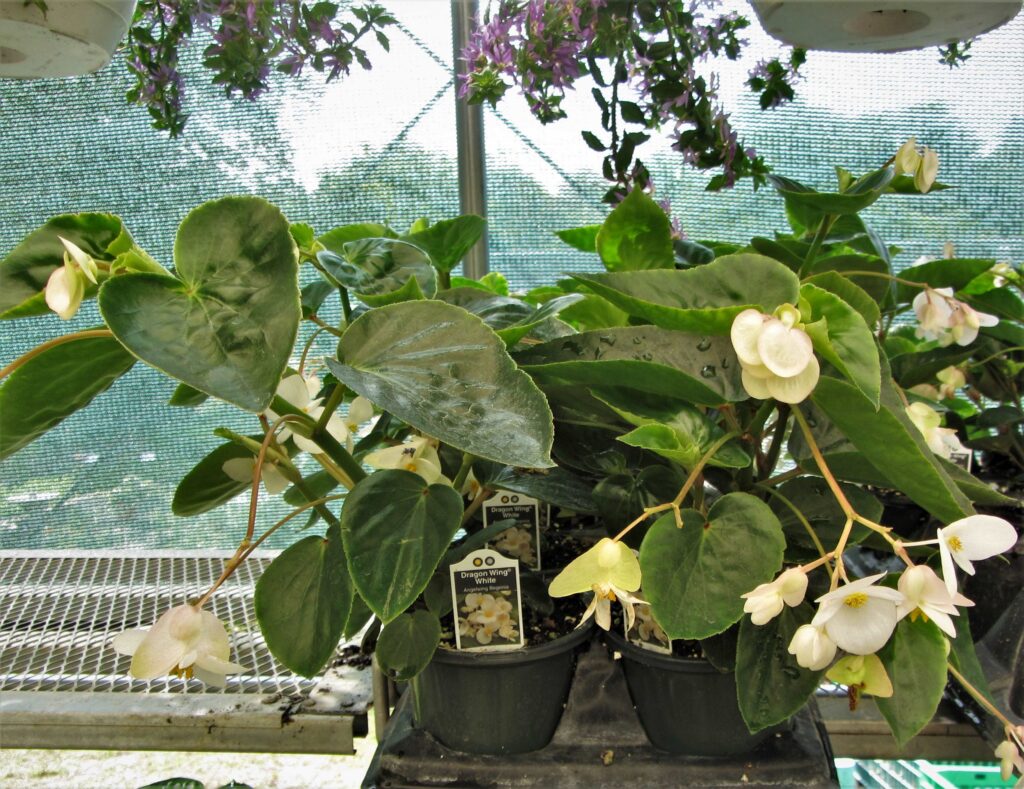
Dragon wing Begonias are a special, sterile hybrid for use in baskets and containers. Flowers come in white, red and pink.
Grow Begonias in consistently moist, fertile soil. Some varieties want the top inch of soil to dry out between waterings. Begonias are tender perennials treated as annuals. Find low growing bedding Begonias sold in 4 packs or 6 packs with annuals in the spring. Rex Begonias and tuberous Begonias are sold in 4” or 6” pots. Angel Wing Begonias are a floriferous type of cane Begonia with showy white, pink, or red flowers that bloom continuously until frost. This is the most sun tolerant of the Begonias.
Attracts pollinators, may be grazed by herbivores
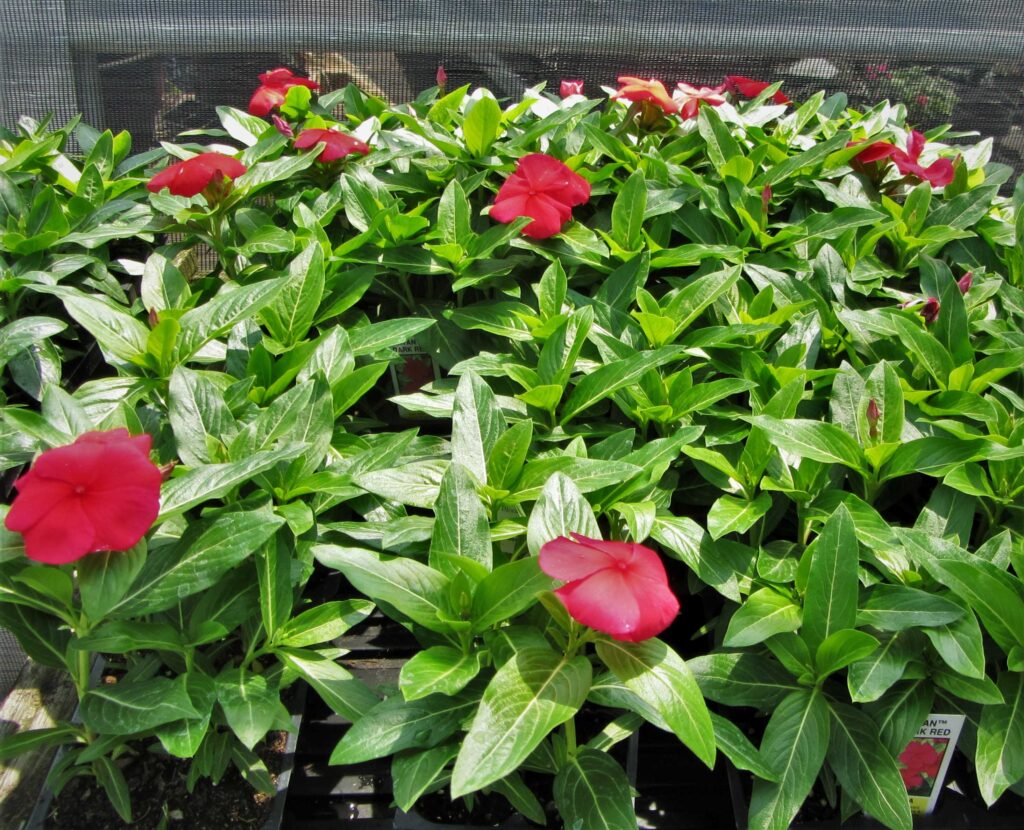
Impatiens hawkeri are more sun tolerant than I. walleriana. Their leaves are thicker, a bit larger, and waxy. The flower shape and size is very similar between the two species.
Impatiens ssp. – Common Impatiens, I. walleriana, bloom reliably in deep shade, partial shade, or dappled sunlight in moist, fertile soil. A tender perennial from Africa, these are a popular bedding plant available in a wide range of colors each spring. Some forms are double, with each flower resembling a miniature rose. These fast growing, spreading and mounding plants to 2’ attract pollinators but are also attractive to herbivores. Grow them only where they will be protected from grazing deer and rabbits. Find shades of white, red, purple and pink. These are easy, low maintenance plants that don’t require deadheading. Pinch back shoots to make a bushier plant.
I. hawkeri, a tender perennial native to islands in the Pacific, are a sturdier version of common impatiens that have a wider range of flower colors and will grow in any light from deep shade to full sun to 3’ tall and wide, depending on the variety. Some varieties have variegated foliage. Give these the same attention to watering and feeding as you give common Impatiens.
Attracts pollinators, may be grazed by herbivores

Hydrangea quercifolia grows in dappled sunlight to shade. Young shrubs may be grown in a container for a year or two before they are planted out into the garden.
Hydrangea ssp. For gardeners planting in very large pots or tubs in partial to full shade, young Hydrangea shrubs bloom in shades of white, blue, pink, purple, and sometimes red. Native H. quercifolia has a distinctive white flower. H. macrophylla hybrids are available in several colors, including light blue. Potted shrubs perform well on their own, or with a trailing annual to drape over the sides of the pot. Grow these shrubs in moist, organically rich soil. Use a container large enough so their roots won’t dry out on hot days.
With appreciation to owners and staff of The Ulster American Homestead Garden Center for their generosity in allowing me to photograph their plants for this article.
All photos by E. L. McCoy
For More Information
American Battlefield Trust. “Short History of the United States Flag.” Accessed May 2023.
Bubis, Jax. “American Revolution Flags.” Revolutionary War and Beyond. 2011.
McCoy, Elizabeth. “Top Plant Picks for Summer Color: Flowers (Part 1)“. JCCWMG.org. May 2022.












